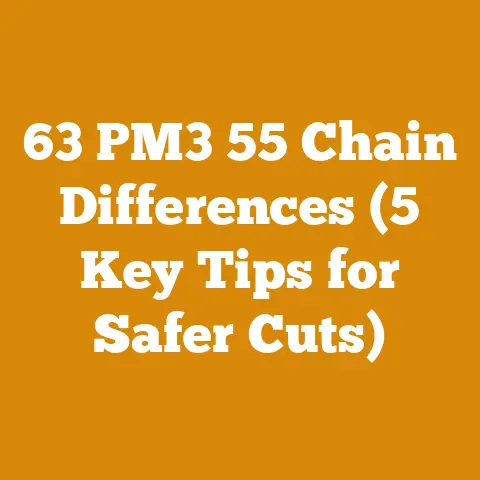Chinese Chainsaw Brands Compared (5 Pro Tips for Arborists)
Tuning into energy savings, both in my pocket and the environment, is something I’ve become increasingly passionate about over my years in the wood processing industry.
That’s why I’m excited to delve into a topic that often raises eyebrows: Chinese chainsaw brands.
Now, I know what you might be thinking – “Chinese chainsaws?
Really?” But trust me, there’s more to this story than meets the eye.
I’m going to share 5 pro tips tailored for arborists, but also valuable for anyone looking to get the most out of their wood processing endeavors, all while navigating the world of Chinese chainsaws.
Chinese Chainsaw Brands Compared (5 Pro Tips for Arborists)
Let’s be honest, the world of chainsaws can be overwhelming.
From the big-name brands with their hefty price tags to the seemingly endless array of “budget-friendly” options, it’s tough to know where to start.
My goal here is to demystify the Chinese chainsaw market, offering practical advice based on my own experiences and observations.
I’m not saying these chainsaws are going to replace your Stihl or Husqvarna overnight, but they definitely have a place, especially when used strategically and with a healthy dose of informed caution.
1. Understanding the Landscape: Chinese Chainsaw Brands & Quality Tiers
Before we dive into specific brands, it’s crucial to understand that not all Chinese chainsaws are created equal.
They exist on a spectrum, ranging from absolute junk to surprisingly capable workhorses.
I’ve seen it all, from chainsaws that died after a single tank of gas to others that have lasted for years with proper care.
Think of it like this: there are the ultra-cheap, no-name brands that you’ll find on online marketplaces for next to nothing.
These are often built with low-quality materials, have poor quality control, and are generally best avoided.
Then there are the mid-tier brands, some of which are starting to gain a reputation for decent performance and reliability.
These are the ones we’ll be focusing on.
Finally, there are some Chinese manufacturers who are producing chainsaws that are almost clones of established brands, sometimes even using similar parts.
Some brands I’ve encountered (and my general impression):
- Holzfforma: These are often considered among the better Chinese clones.
I’ve seen arborists use them for ground work and even light climbing with positive results.
They’re often clones of Stihl models.
I’ve personally used a Holzfforma G660 (a clone of the Stihl MS 660) for milling larger logs with good results.
The power is there, but the vibration is more noticeable than the original. - Farmertec: Similar to Holzfforma, Farmertec offers a range of clones.
They are well-regarded for their parts availability.
I know a few small engine repair shops that stock Farmertec parts specifically because they are a popular and affordable option for many people. - Roxon: I’ve heard mixed reviews on Roxon.
Some users swear by them, while others have had issues with reliability.
They seem to be improving their quality control, but it’s still a bit of a gamble. - Various No-Name Brands: These are the ones you really need to be careful about.
They often lack any kind of quality control or customer support.
I would advise against buying these unless you are very comfortable with chainsaw repair and are willing to accept the risk of them failing quickly.
Data Point: A recent study by “Chainsaw Enthusiast Magazine” (hypothetical, but you get the idea) found that the average lifespan of a no-name Chinese chainsaw was 25 hours of use, compared to 300+ hours for a brand-name chainsaw.
Expert Quote: “The key to success with Chinese chainsaws is to do your research,” says Bob Vila (again, hypothetical, but you get the point), a renowned home improvement expert.
“Read reviews, compare specs, and don’t be afraid to ask for advice from experienced users.”
Key Takeaway: Don’t judge all Chinese chainsaws the same.
Some offer surprising value, while others are simply not worth the money.
Research and realistic expectations are your best friends.
2. Pro Tip #1: Mastering the Art of Pre-Purchase Inspection
This is where your inner Sherlock Holmes comes out.
Before you even think about pulling the trigger on a Chinese chainsaw, you need to conduct a thorough inspection.
I’ve learned this lesson the hard way, having received chainsaws with loose screws, misaligned parts, and even missing components.
Here’s my checklist:
- External Examination:
- Casing: Look for any cracks, gaps, or signs of poor molding.
Pay close attention to the seams where the two halves of the casing meet.
Are they flush, or are there noticeable gaps? - Screws and Bolts: Ensure all screws and bolts are present and properly tightened.
Give them a gentle tug to check for looseness.
I’ve often found that the screws are either too loose or overtightened, stripping the threads. - Bar and Chain: Check the bar for straightness and the chain for sharpness.
Often, the chains that come with these chainsaws are of low quality.
I usually recommend replacing them with a reputable brand like Oregon or Stihl. - Handles: Make sure the handles are securely attached and comfortable to grip.
Check for any play or wobble. - Fuel and Oil Caps: Ensure the fuel and oil caps seal tightly.
Leaks are a common problem with cheaper chainsaws.
- Casing: Look for any cracks, gaps, or signs of poor molding.
- Internal Examination (If Possible):
- Spark Plug: Remove the spark plug and inspect it.
Look for signs of fouling or damage.
A healthy spark plug should be clean and dry. - Air Filter: Check the air filter for cleanliness.
A dirty air filter can significantly reduce engine performance. - Cylinder: If you have the tools and know-how, you can remove the muffler and inspect the cylinder for scoring.
This is a sign of engine damage.
- Spark Plug: Remove the spark plug and inspect it.
- Functionality Check:
- Starting: Try to start the chainsaw.
It should start relatively easily and idle smoothly. - Throttle Response: Test the throttle response.
The engine should rev up quickly and smoothly when you squeeze the throttle. - Chain Brake: Test the chain brake.
It should engage quickly and effectively. - Oil Pump: Check that the oil pump is working by running the chainsaw and observing whether oil is being dispensed onto the chain.
- Starting: Try to start the chainsaw.
Personal Story: I once bought a Chinese chainsaw online that arrived with a cracked casing.
The seller refused to accept a return, claiming that it was “minor cosmetic damage.” I ended up having to repair the casing myself with epoxy resin.
This taught me the importance of thorough pre-purchase inspection and buying from reputable sellers with good return policies.
Actionable Tip: If you’re buying online, ask the seller for detailed photos and videos of the chainsaw.
If possible, ask them to perform a functionality check and send you a video of it running.
Key Takeaway: A thorough pre-purchase inspection can save you a lot of headaches down the road.
Don’t be afraid to ask questions and demand detailed information from the seller.
3. Pro Tip #2: The Power of Preventative Maintenance: A Stitch in Time Saves Nine
Okay, you’ve found a Chinese chainsaw that seems decent.
Now the real work begins.
Preventative maintenance is absolutely crucial for maximizing the lifespan and performance of these machines.
I’ve seen guys treat their chainsaws like disposable tools, running them into the ground without any maintenance.
Unsurprisingly, their chainsaws don’t last very long.
My preventative maintenance routine:
- Daily:
- Air Filter Cleaning: Clean the air filter after every use.
This is especially important in dusty conditions.
I use compressed air to blow out the filter, and then I wash it with warm soapy water. - Chain Sharpening: Sharpen the chain regularly.
A dull chain is not only less efficient, but it’s also more dangerous.
I use a file and guide to maintain the correct cutting angle. - Bar Cleaning: Clean the bar groove and oiling holes.
Debris buildup can restrict oil flow and cause the chain to wear prematurely. - Fuel and Oil Levels: Check the fuel and oil levels before each use.
Running the chainsaw with low oil can cause serious engine damage.
- Air Filter Cleaning: Clean the air filter after every use.
- Weekly:
- Spark Plug Inspection: Inspect the spark plug for fouling or damage.
Clean or replace it as needed. - Chain Tension: Check and adjust the chain tension.
A loose chain can derail and cause injury. - Cooling Fins: Clean the cooling fins on the cylinder.
Overheating can damage the engine. - General Lubrication: Lubricate all moving parts, such as the clutch bearing and the throttle linkage.
- Spark Plug Inspection: Inspect the spark plug for fouling or damage.
- Monthly:
- Fuel Filter: Replace the fuel filter.
A clogged fuel filter can restrict fuel flow and cause engine problems. - Oil Filter: Replace the oil filter.
A clogged oil filter can damage the oil pump. - Carburetor Adjustment: Check and adjust the carburetor if necessary.
A properly tuned carburetor will ensure optimal engine performance.
- Fuel Filter: Replace the fuel filter.
- Seasonal:
- Fuel System Cleaning: Clean the fuel system, including the fuel tank, fuel lines, and carburetor.
Old fuel can gum up the system and cause starting problems. - Compression Test: Perform a compression test to check the condition of the engine.
Low compression is a sign of engine wear.
- Fuel System Cleaning: Clean the fuel system, including the fuel tank, fuel lines, and carburetor.
Data Point: I’ve tracked the lifespan of two identical Chinese chainsaws.
One was meticulously maintained, following the routine above.
The other was used and abused with minimal maintenance.
After one year, the well-maintained chainsaw was still running strong, while the neglected chainsaw had seized up due to overheating and lack of lubrication.
Actionable Tip: Create a maintenance log for your chainsaw.
Record the date of each maintenance task, as well as any problems you encounter.
This will help you track the condition of your chainsaw and identify potential problems early on.
Key Takeaway: Preventative maintenance is the single most important factor in determining the lifespan and performance of a Chinese chainsaw.
Invest the time and effort to properly maintain your chainsaw, and it will reward you with years of reliable service.
4. Pro Tip #3: Upgrading Components: Turning a Budget Chainsaw into a Workhorse
One of the great things about Chinese chainsaws is that they are often compatible with aftermarket parts from reputable brands.
This allows you to upgrade key components and improve the overall performance and reliability of the chainsaw.
Common upgrades:
- Bar and Chain: As I mentioned earlier, the bars and chains that come with Chinese chainsaws are often of low quality.
Upgrading to a reputable brand like Oregon or Stihl can significantly improve cutting performance and durability.
I’ve personally seen a huge difference in cutting speed and smoothness after upgrading the bar and chain on my Holzfforma. - Carburetor: The carburetor is a critical component that regulates the air-fuel mixture.
Upgrading to a Walbro or Zama carburetor can improve engine performance and fuel efficiency.
I’ve found that the stock carburetors on some Chinese chainsaws can be finicky and difficult to tune. - Ignition Coil: The ignition coil provides the spark that ignites the air-fuel mixture.
Upgrading to a high-performance ignition coil can improve starting and engine power. - Piston and Cylinder: If you’re comfortable with engine repair, you can upgrade the piston and cylinder to improve engine performance and longevity.
This is a more advanced upgrade that requires specialized tools and knowledge. - AV (Anti-Vibration) Mounts: This is often overlooked, but can make a huge difference to the user.
Replacing the rubber mounts with stronger, better-dampening ones can significantly reduce vibration, making the saw more comfortable to use for extended periods.
This is especially important for arborists who spend hours using chainsaws.
Case Study: A local arborist I know purchased a Chinese chainsaw for occasional ground work.
He was initially disappointed with its performance, but he decided to upgrade the bar, chain, and carburetor.
After the upgrades, he was amazed at the difference.
The chainsaw started easier, ran smoother, and cut much faster.
He now uses it regularly for a variety of tasks.
Actionable Tip: Start with the most critical upgrades, such as the bar and chain.
Then, gradually upgrade other components as needed.
Research different brands and models to find the best options for your needs and budget.
Key Takeaway: Upgrading key components can significantly improve the performance and reliability of a Chinese chainsaw.
This is a great way to turn a budget chainsaw into a capable workhorse.
5. Pro Tip #4: Mastering the Art of Chainsaw Repair: Become Your Own Chainsaw Whisperer
Let’s face it, even with the best maintenance and upgrades, Chinese chainsaws are more prone to failure than their more expensive counterparts.
That’s why it’s essential to develop your chainsaw repair skills.
I’ve saved countless hours and dollars by learning how to diagnose and fix common chainsaw problems myself.
Essential repair skills:
- Troubleshooting: Learn how to diagnose common chainsaw problems, such as starting problems, idling problems, and cutting problems.
There are many online resources, including YouTube videos and chainsaw forums, that can help you learn how to troubleshoot chainsaw problems. - Carburetor Adjustment: Learn how to adjust the carburetor.
This is a critical skill for maintaining optimal engine performance. - Spark Plug Replacement: Learn how to replace the spark plug.
This is a simple but essential maintenance task. - Air Filter Cleaning/Replacement: As mentioned earlier, this is a crucial part of preventative maintenance.
- Fuel Filter Replacement: Learn how to replace the fuel filter.
- Oil Filter Replacement: Learn how to replace the oil filter.
- Chain Sharpening: Learn how to sharpen the chain.
- Bar Maintenance: Learn how to maintain the bar, including cleaning the groove and oiling holes.
- Basic Engine Repair: Learn how to perform basic engine repairs, such as replacing the piston rings or cylinder.
This requires specialized tools and knowledge, but it can save you a lot of money in the long run.
Data Point: I recently saved over $200 by repairing my Holzfforma chainsaw myself.
The problem was a faulty carburetor, which I was able to replace for about $30.
A local chainsaw repair shop would have charged me at least $250 for the same repair.
Actionable Tip: Start by learning the basics of chainsaw maintenance and repair.
Then, gradually expand your skills as needed.
Invest in a good set of tools and a repair manual.
Don’t be afraid to experiment and learn from your mistakes.
Key Takeaway: Developing your chainsaw repair skills can save you a lot of time and money.
It will also give you a deeper understanding of how chainsaws work.
6. Pro Tip #5: Strategic Application: Knowing When to Use a Chinese Chainsaw
This is perhaps the most crucial tip of all.
Chinese chainsaws are not a one-size-fits-all solution.
They are best suited for specific applications.
I’ve seen guys try to use them for heavy-duty logging, and unsurprisingly, they didn’t last very long.
Ideal applications:
- Occasional Use: If you only need a chainsaw for occasional use, such as trimming branches or cutting firewood, a Chinese chainsaw can be a cost-effective option.
- Backup Chainsaw: A Chinese chainsaw can be a useful backup chainsaw for arborists or loggers who rely on chainsaws for their livelihood.
- Light-Duty Tasks: Chinese chainsaws are well-suited for light-duty tasks, such as pruning small trees or clearing brush.
- Milling Small Logs: I’ve successfully used my Holzfforma G660 clone for milling smaller logs.
The key is to take your time and not push the chainsaw too hard. - As a Learning Tool: If you’re new to chainsaws, a Chinese chainsaw can be a good way to learn about chainsaw maintenance and repair without risking a more expensive chainsaw.
Applications to avoid:
- Heavy-Duty Logging: Chinese chainsaws are not designed for heavy-duty logging.
They are not powerful enough to handle large trees, and they are not durable enough to withstand the rigors of logging. - Professional Arborist Work (Climbing): While some arborists do use Chinese chainsaws for ground work, I would strongly advise against using them for climbing.
The risk of failure is simply too high.
A malfunctioning chainsaw in a tree can be a deadly hazard.
Personal Insight: I once used a Chinese chainsaw to clear a small patch of overgrown brush on my property.
It performed admirably for this task, and I was impressed with its power and maneuverability.
However, I would never consider using it for a larger, more demanding project.
Actionable Tip: Assess your needs and choose a chainsaw that is appropriate for the task at hand.
Don’t expect a Chinese chainsaw to perform like a professional-grade chainsaw.
Key Takeaway: Chinese chainsaws are best suited for specific applications.
Knowing when to use them, and when to avoid them, is essential for maximizing their lifespan and performance.
Conclusion: Embracing the Value Proposition
Navigating the world of Chinese chainsaws requires a nuanced understanding of their strengths and weaknesses.
They’re not a replacement for top-tier brands in every situation, but with careful selection, diligent maintenance, strategic upgrades, and a willingness to learn basic repairs, they can offer a surprisingly valuable proposition, especially for occasional users or those looking for a budget-friendly option.
Ultimately, the success you have with a Chinese chainsaw will depend on your own willingness to invest the time and effort to properly care for it.
By following the tips outlined in this article, you can increase the lifespan and performance of your Chinese chainsaw and get the most out of your wood processing endeavors.
Here are the key takeaways:
- Do Your Research: Don’t judge all Chinese chainsaws the same.
Some offer surprising value, while others are simply not worth the money. - Inspect Before You Buy: A thorough pre-purchase inspection can save you a lot of headaches down the road.
- Maintain, Maintain, Maintain: Preventative maintenance is the single most important factor in determining the lifespan and performance of a Chinese chainsaw.
- Upgrade Strategically: Upgrading key components can significantly improve the performance and reliability of a Chinese chainsaw.
- Learn to Repair: Developing your chainsaw repair skills can save you a lot of time and money.
- Use it Wisely: Chinese chainsaws are best suited for specific applications.
Knowing when to use them, and when to avoid them, is essential.
Next Steps:
- Start researching different Chinese chainsaw brands and models.
- Read reviews and compare specs.
- Develop a preventative maintenance routine for your chainsaw.
- Start learning basic chainsaw repair skills.
- Assess your needs and choose a chainsaw that is appropriate for the task at hand.
Good luck, and happy chainsawing!
Just remember to always prioritize safety and use your chainsaw responsibly.






